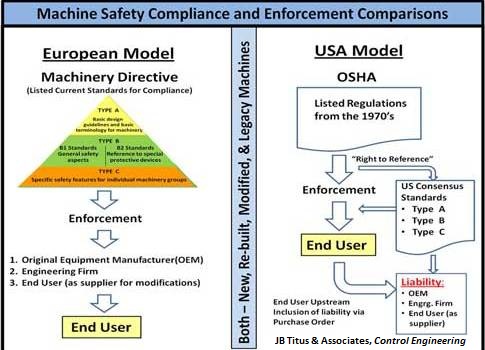Can a U.S. original equipment manufacturer (OEM) ship a machine without safety integrated into or included as part of the machine? Aren’t there regulations requiring machine manufacturers to provide machine guarding? An example of basic machine safety is an emergency stopping device, such as an e-stop.

Can an original equipment manufacturer (OEM) in the U.S. really ship a machine without safety included or integrated into the machine? Aren’t there regulations requiring machine manufacturers or machine builders to provide machine guarding? All OEMs must include some basic machine safety on a machine when they sell that machine to a customer (end user) within the United States.
An example of basic machine safety is an emergency stopping device such as an e-stop. However, an OEM has the flexibility to provide a main disconnecting device for performing an emergency stop function in some cases. This function and other machine specific safety-related functions are covered as requirements in some OSHA regulations as well as in some “B” and “C” level consensus standards for machine safety.
However, these requirements do not address all hazards associated with an installed machine for operators, maintenance, engineers or clean-up personnel and others operating within a manufacturing environment. Today, a risk assessment is required by regulation for installed machines to determine all hazards and remediation measures.
1. In the U.S. we have OSHA which was created in 1970 as a regulatory arm of the government to provide safety in the work place. OSHA regulations are specifically written to address employer provided safety. OSHA’s General Duty Clause specifically says:
Each employer —
(1) shall furnish to each of his employees employment and a place of employment
which are free from recognized hazards that are causing or are likely to cause
death or serious physical harm to his employees;
(2) shall comply with occupational safety and health standards promulgated under
this Act.
Therefore, to the amazement of many in an audience, I explain that in general an OSHA inspector will not examine a machine being built by an OEM. The OSHA inspector will inspect an OEM’s work practices in manufacturing but that machine only will be subject to machine safety enforcement once it’s owned and installed for production by an employer (end user).
There are some levels of machine safety standards that are referenced by OSHA in addition to their regulations and by “reference” they are also enforceable by OSHA. Practically all OSHA enforcement for machine safety is, by default, directed at the end user employer.
2. Some levels of basic safety are required by OSHA regulations and by industry consensus standards. Some examples are:
(1) 1910.217 – Mechanical power presses, for various design and safety functions like slide braking, clutch and brake control, two hand control, etc.
(2) ANSI B11.1; Safety Requirements for Mechanical Power Presses
(3) NFPA 79; Electrical Standard for Industrial Machinery
The ANSI and NFPA standards include both basic machine safety standard requirements as well as additional (beyond OSHA) requirements. However (in my opinion), since an OEM is not an end user employer, the OEM may ship machines to end users without all of the eventually required safety measures installed.
I have seen this picture changing over the past 10 plus years in the consensus standards update cycles, which have been requiring more machine safety measures provided by OEMs. Yet, OSHA’s enforcement practice is still primarily focused on the end user.Has this presented you with any new perspectives about responsibility of machine safety in the U.S.? Do you have some specific topic or interest that we could cover in future machine safety blog posts? Add your comments or questions below.Related articles: Read other Control Engineering machine safety articles.Contact: https://www.jbtitus.com for “Solutions for Machine Safety.”



